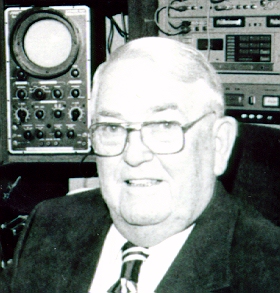
Year Born: 1906
Year Died: 1990
Year of Induction: 1993
Pioneer – Member of CAB Hall of Fame
Swan, Ernie (1906-1990)
Ernie Swan was born in Vasey, Ontario in 1906, and later moved to nearby Midland, where he became interested in this new fad “radio”, which eventually produced the town’s first radio station, CKPR, which he managed for several years. When the shipyard closed in Midland, the station moved in 1931 to Port Arthur (with studio and offices in Fort Willam, across the river, and Ernie’s dream of owning his own radio station never came to pass.
He moved to Toronto where he became a legendary figure in Canadian broadcast engineering during his tenure as chief engineer of CKCL (later CKEY) Toronto from 1930 to 1944. He then went on to trail-blaze new techniques in radio transmission that benefited existing stations and opened up opportunities for increasing the efficiency and number of stations that could occupy the AM dial.
The big problem facing all stations was co-channel interference from other cities assigned to the same frequency. During the hours of darkness, the interference was really severe and some stations experienced difficulties in properly serving their own areas. American stations which were permitted to use higher power than Canadian stations represented the greater problem. Ernie had researched and developed some theories on overcoming this situation, but had difficulty in enlisting financial support for experimentation that would help prove them.
It was not until the latter days of WW II that a number of companies in Montreal and Toronto came to his aid. Purchasing a plot of farmland near Toronto Ernie set about splitting the broadcast signal and feeding it to two towers.
The success of this experiment resulted in the equivalent of 3,000 watts of power being generated from 1,000 watts. From this grew “directional broadcasting” which involved reducing the power in the direction of other stations on the same frequency (particularly the U. S. stations) and focusing it primarily north, east and west. The extra strength so generated enabled the stations to virtually “blot out” the distant station in the area of Canada in which the Canadian station was licensed to serve. The concept was much like placing a mirror behind a light bulb. In due course, as both Canadian and American stations increased their power, they were obliged to provide this protection to other stations on the same frequency, and the theories developed by Ernie Swan became the “norm” in the industry.
Ernie Swan also came up with a novel procedure for installing radio transmission ground systems – a circular spider-web-like pattern of copper wires buried in the ground surrounding each tower. Ernie found that by using a small caterpillar tractor with a plough attachment, he could bury 25,000 feet of the systems’ copper wires. Running from coils through a length of pipe, the wires were buried in the furrows with the help of a heavy chain dragging over them.
With the arrival of television, Ernie formed his own company – E. Swan TV Company Limited, which specialized in the design and installation of master antennas on apartment and other multi-occupancy buildings for television reception. He remained as president of the company until the time of his death in 1990.
Posthumously, in 1993, Ernie Swan was inducted into the CAB Broadcast Hall of Fame.
Written by Ross McCreath – April, 1996
